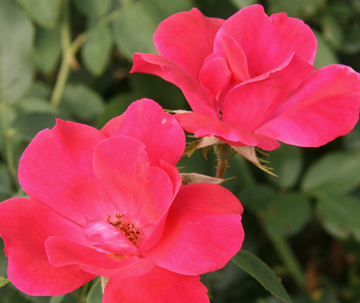Editor’s Note: We have an office full of green thumbs. Many of us enjoy getting our hands dirty in the garden and have some perplexing plant and garden questions for our buddy and garden adventurer L.A. Jackson. Perhaps you face the same plant conundrums. Check out Jackson’s solutions to our pressing botanical questions.
Q. What would make the best houseplants for someone with a “brown thumb” (one for whom most houseplants die in a very short time)?
— Sheri Elderfield, Bookkeeper
A. Well, if you think your thumb is THAT brown, consider pretty plastic plants that only need to be dusted occasionally. But before you resort to such artificial indoor enhancements, let’s take another crack at the real thing. For low-light settings, consider snake plant (Sansevieria trifasciata), philodendron (Philodendron scandens), Boston fern (Nephrolepsis exaltata) cast iron plant (Aspidistra elatior) or Chinese evergreen (Aglaonema sp.). Tough plants that will do well in brighter locations include dumb cane (Dieffenbachia sp.), rubber plant (Ficus elastica), peperomia (Peperomia sp.), pothos (Epipremnum aureum), spider plant (Chlorophytum comosum) and croton (Codiaeum sp.).
I also have to think your brown thumb ways might be the result of too little or too much water. It is a simple fact that, if you don’t water your plants, they will die, but most of the time, such living greenery succumbs from too much water. Wanting to keep your plants happy, you water them … and then, you water them again … and then, just to make sure, you water them one more time. Big mistake. Too much water leads to many problems, with the most prominent being root rot. And if the roots rot, the plant won’t be too far behind. Overwatering occurs most often in the winter when plant owners continue to water their plants just like they did in the summer. Instead, houseplants should be watered sparingly in the cooler times of the year — usually once every two to three weeks. This is a general recommendation, meaning the next time you buy a houseplant, go online and find out everything you can about the basic requirements of your new botanical pride and joy.
Q. Is there a way to have an organic garden without composting and using a worm garden?
— Chris Long, Account Executive
A. So, you don’t want your garden to be the poster child for Mother Earth News, eh? I always say that adding compost is the No. 1 way to improve your garden, but there is a sneaky way to incorporate this excellent soil conditioner without actually having a compost pile. Borrowing from the French Intensive way to garden, you simply dig your rows out or beds out to a depth of 12 to 18 inches, and then use a garden fork or shovel to loosen up the soil in the bottom of the hole another foot or so deep. Next, add a mighty dose of lawn clippings and leaves that have been run over with the lawn mower into the hole while putting back the dirt that was originally in the hole. This will create a raised bed with liberal amounts of organic matter that does nothing but good things for plants. However, since this isn’t a true compost pile and won’t break down as fast, it is best to do this deed in the fall or early winter to allow some decomposition to occur before spring planting. As far as the worms go, in no matter what form, if you make compost, they will come.
Q. What are some of the best all-natural home remedies for deterring pests from plants? — Kris Schultz, Eastern Regional Sales Manager
A. As far as four-legged, furry pests go, I have had some success sprinkling a dollar store can of fine ground black pepper on my plants to keep deer and rabbits as well as cats and dogs away. Think about it: Sniffing black pepper gives you the sneezing fits, right? Well, what do you think it does to a critter with a nose that is way more sensitive than yours? Also, check out the organic repellents from I Must Garden (imustgarden.com), a Chapel Hill-based company that has some animal chasers I have found to be pretty effective. As far as getting rid of Japanese beetles, hand picking them and tossing them in a bucket of soapy water is very successful but high on the “Yuck!” scale, so think about using insecticidal soap or Neem oil sprays, both of which are organic pesticides.
Q. Other than traps or poisons, what methods can be used to control moles and voles?
— Glenn Gillen, PR Account Manager
A. Well, if you have a slight problem with moles and voles, get a cat. If you have a big problem, get lots of cats. There is also a neat way to discourage these tunneling terrors from your garden — rocks. Not just any rocks, but an interesting soil conditioner called PermaTill, which is composed of small, porous pebbles that physically keep dense clay soil from compacting. As an added bonus, when used as 2-inch base in a new planting hole or as a fill for 2-inch-wide trenches around susceptible plants, PermaTill discourages moles and voles from tunneling, so they go somewhere else. If you want to find a lawn and garden store that carries PermaTill, search on the Web site: www.permatill.com.
Q. When and how should I prune my plants, specifically roses? My “Knockout” roses are constantly flowering, so I’m never sure when to trim them, but they grow so fast that they start to look unruly quickly if they’re not pruned.
— Kati Knowland, Special Projects Manager
A. Even though Gertrude Stein insisted that “A rose is a rose is a rose,” when it comes to pruning, different roses are cut back at different times. For your “Knockout” rose, which can bloom from early spring until deep into November, it should be snipped back before new growth starts, meaning about early to mid February. Concentrate on cutting out old and spindly canes and then give the rest of the bush a shaping trim. This trim can be brutal, too — you can take one-third to one-half the height off, if you want. No pruning should be done the year after a “Knockout” has been planted, and it is best to prune established plants only about every three years.
L.A. Jackson is the former editor of Carolina Gardener magazine. If you would like to ask him a question about your garden, go to his Web site at southeastgardeningwithla.com












